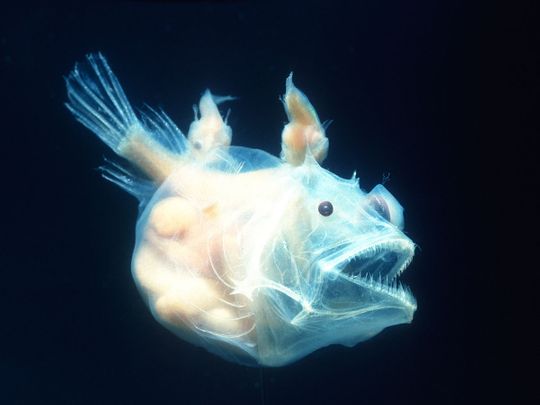
It’s dark, cold, and often has low levels of oxygen – the deepest part of the sea is otherworldly, full of strange-looking creatures that look like they’re from outer space.
Click start to play today’s Spell It, where we go even further than the ‘Titanic’ shipwreck, to learn why creatures of the deep-sea look like they could be aliens.
Imagine swimming in pitch-black water, and suddenly encountering something out of a horror movie – a creature with bulging eyeballs and horrific, sharp teeth. Although deep-sea creatures may look like villains from outer space, their appearance is just the reflection of the extreme environment they live in.
According to a July 2023 report in the US-based science news website LiveScience, the deep ocean begins at 200 metres below the surface, and has no light, high pressure, low availability of food and is much colder than the rest of the ocean, with temperatures averaging 4°C.
So, to ensure they have the best chance of finding food, deep-sea creatures have some unique features. Foremost among them is a gargantuan set of jaws. Pelican eels, for instance, have mouths that stretch open to more than five times their normal size – they suck in their prey, along with mouthfuls of water.
Another deep-sea creature, Sloane’s viperfish, has fangs that are so massive, it can’t shut its mouth – if it does, it will puncture its brain. Its teeth have other features too, according to the LiveScience report. They’re extremely sharp and transparent, allowing the viperfish to hide its biggest weapon from prey until they’re too close and it’s too late.
Other deep-sea animals are able to generate their own light, via bioluminescence. The most well-known among these creatures (thanks in part to its appearance in the 2003 animated film, Finding Nemo) is the deep-sea anglerfish. Like something out of a nightmare, the anglerfish uses a glow-in-the-dark light at the end of a rod attached to its head, drawing curious marine creatures closer, until they’re captured by the fish’s razor-sharp teeth.
Bioluminescence exists in more than 75 per cent of deep-sea fish, according to a 2017 study in the journal Nature. The giant hatchetfish, for instance, can even use it like an invisibility cloak, to hide from other marine creatures, and has the ability to dim or brighten its light.
A final trait found in deep-sea animals is, well, squishiness. According to the LiveScience report, one extremely flabby fish that can be found in depths of between 600m and 1,200m in the waters outside Australia, is the blobfish. In its environment, the pressure can be crushing – more than 100 times that on the surface. So, the blobfish’s body is extraordinarily flabby, without a strong skeleton, to cope.
While these marine creatures may seem bizarre to us, they live in an ecosystem that covers over 70 per cent of the planet – the largest habitat on Earth. So, are they truly bizarre, or are we land-dwellers the strange-looking ones?
What do you think of these creatures? Play today’s Spell It and tell us at games@gulfnews.com.




